Modern heaters allow you to reduce the cost of heating the premises, additionally help to protect them from adverse weather conditions. Often, effective polystyrene foam and Penoplex are used for this. You just need to know their characteristics, and understand that it is better to use expanded polystyrene or Penoplex for your purpose. The quality of insulation of any building directly depends on the material used. Inexperienced developers often confuse their features when choosing a heater.
What is expanded polystyrene
This insulation has been used in European countries for over 50 years. It attracts with its low cost and the presence of closed pores in the material layer, which does not contain freon. You can buy it in almost every building materials store. Although inexpensive, it can keep warm well. Expanded polystyrene externally is a foam in which there is a huge amount of frozen air bubbles.
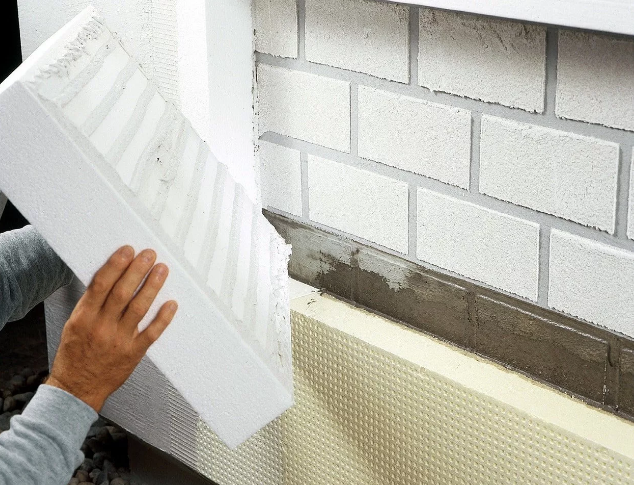
It contains up to 85% of the air, which increases the thermal insulation characteristics. Dense material, does not allow obtaining high thermal insulation characteristics. Air bubbles, enclosed in a solidified polystyrene shell, successfully combine 2 positive characteristics - layer density and low thermal conductivity.
Due to its density, the material practically does not absorb moisture. But this property does not prevent him from "breathing". Fire safety is achieved by adding fire retardants to the composition. These components prevent combustion, without them the polymer will burn well. It has high biological resistance, fungi and mold cannot develop on polymeric materials.
When insulating buildings, it must be borne in mind that expanded polystyrene cannot make:
- Low noise protection. Rigid air bubbles serve as a resonator rather than a noise absorber;
- Poor resistance to aggressive substances. Turpentine, drying oil, any types of varnish and acetone are dangerous for him. But simple minerals, soap solution and cold bitumen do not affect;
- Oxidises when the temperature rises. In the heat, harmful substances begin to be released.
What is Penoplex
Penoplex is extruded polystyrene. It is a common material, often used for thermal insulation of roofs, ceilings and walls; even floors are insulated with it.
For insulating materials, the ability to absorb moisture is the main characteristic, because the raw structure cannot retain heat.
Important! Tests were carried out - Penoplex plates were immersed in water for a month. During this time, moisture was absorbed for the first 10 days no more. At the end of the tests, the slabs contained no more than 0.6% of the total volume of the heat insulator. This suggests that water enters only the outer cells of Penoplex, damaged during the cutting of the slabs, and moisture cannot penetrate into the closed capsules inside the structure.
Material properties: what is the difference
The thermal conductivity coefficient of expanded polystyrene is lower than that of Penoplex, which is the main difference. It is in the range of 0.028-0.034 W / (m * K). The denser the structure of the material, the worse it retains heat. So, for expanded polystyrene with a density of 45 kg / m3, this characteristic is equal to 0.03 W / (m * K).
Any expanded polystyrene does not like exposure to the sun. It is simply destroyed by the sun's rays - with prolonged exposure to ultraviolet light, the material loses its strength and becomes not so elastic. Then destruction occurs under the influence of wind, rain and snow.
With proper use - protection from external influences with a layer of plaster or decorative finish, the material can be used for about 30 years. But an inexperienced craftsman can make mistakes when installing insulation plates.
Errors in calculating the thickness of the heat insulator can lead to troubles. For example, many people think that a thick layer of expanded polystyrene will make the insulation more effective and the material will last longer. But in reality, there is a mistake here - a thick layer of insulation, when the temperature changes, will go in waves and cracks will appear on it, through which cold air will begin to flow. In Europe, buildings are trimmed from the outside with a layer of up to 3.5 cm.
The differences between Penoplex and expanded polystyrene are in a higher density, due to which it withstands mechanical stress better. It has a lower vapor permeability, or rather, steam practically does not penetrate through it, therefore the thermal characteristics of the insulation are higher. A layer of material with a thickness of only 2 cm in terms of its ability to retain heat can be compared with a 37 cm thick brickwork.
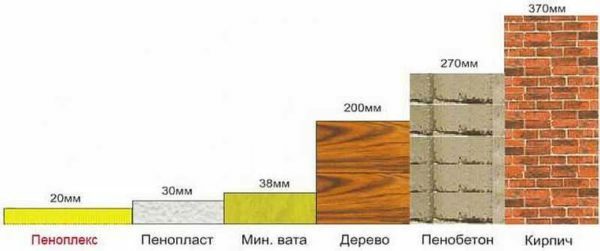
These positive qualities are determined by the scope of Penoplex.
Important! It is mainly used for thermal insulation of places where resistance to mechanical stress is required and low vapor permeability is important.
Specifically, Penoplex is used in places such as:
- Thermal insulation of the floor;
- Lay as an intermediate layer under the screed;
- When installing the floor on logs;
- Warming when installing a warm floor;
- Organization of blind areas around the building;
- Insulation of the basement of a non-residential building;
- On the roofs;
- Thermal insulation of septic tanks.
In addition, it is used to insulate interior walls and facades. But here you need to take into account that Penoplex does not allow moisture to pass through, and you need to make sure that the vapors are removed. An effective ventilation system will be required.
If you want to get "breathing" walls - Penoplex will not work for you, since dampness will not be removed through the thickness of Penoplex.
Production
Expanded polystyrene is made in the process of foaming polystyrene granules. Different technologies make it possible to obtain a foamed or extruded product.
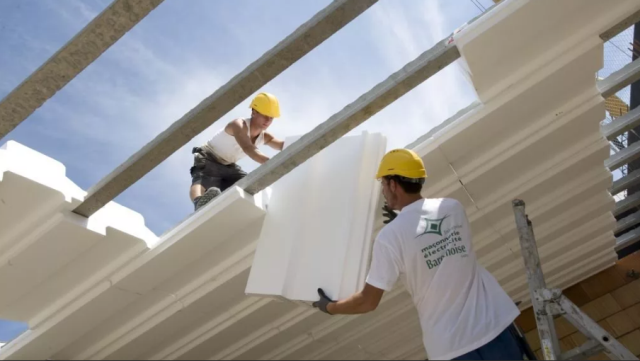
Extruded material is more difficult to obtain, and it will cost more, since you need to organize and maintain a special extruder.
The production process itself is not complicated, it takes place in several stages:
- The granules are treated with steam, as a result of which they greatly increase in size;
- The expanded granules are kept in a drying compartment;
- The product is kept for 4-12 hours;
- Expanded polystyrene is laid in special forms;
- The product is heated under pressure for 6–12 minutes;
- The finished slabs are cooled;
- To remove moisture, the blocks are kept in the warehouse for 2-4 weeks.
The process of making Penoplex occurs continuously, the heated raw material is passed through the extruder, while supplying a CFC-free mixture. It turns out a heater with very small structure cells. The complex of equipment for the manufacture of a heat insulator is divided into several units.
Preparation system - polystyrene with the necessary additives enters the mixer, from which the finished composition is fed to the extruder. It consists of 2 units, the first is necessary for melting the preparation of the mixture and mixing it with the foaming component. The second device finally mixes the constituent mixtures, after which they are pushed through the slotted die and polystyrene foam sheets are obtained.
Thermal conductivity
The insulating properties of the expanded polystyrene layer primarily depend on its density.
| Density (kg / m3) | Thermal conductivity (W / mK) |
| 10 | 0.044 |
| 15 | 0.038 |
| 20 | 0.035 |
| 25 | 0.034 |
| 30 | 0.033 |
| 35 | 0.032 |
Material manufacturers use graphite-based additives to reduce the effect of density on thermal conductivity.
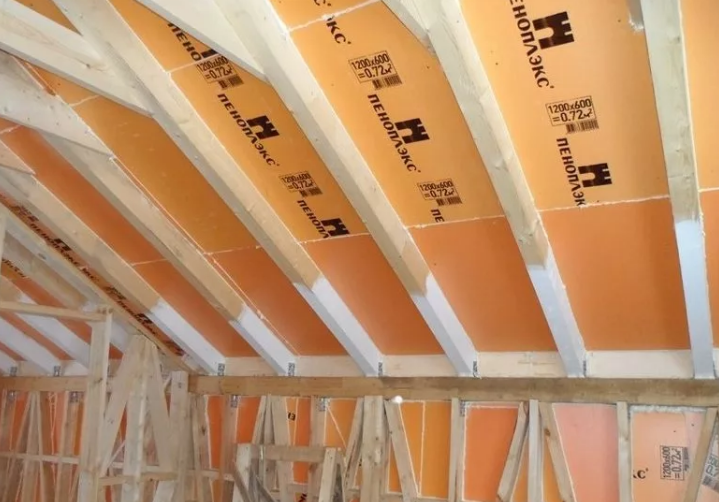
Penoplex has a small pore size (within 0.1-0.3 mm) and their reliable isolation among themselves, improves the insulating ability of any type of material. When building different objects, you need to choose the brands of heat insulator suitable for a specific purpose, since all buildings are operated in different conditions:
- Grade "K" - for the protection of flat or pitched roofs, specific density - 28-33 kg / m3;
- Grade "C" - for the protection of external and internal walls, specific density - 25-35 kg / m3;
- Brand "F" - to protect basements and foundations, the material is well resistant to biological effects and moisture, specific density - 37 kg / m3;
- Brand "Comfort" - a series of universal purposes with a specific density of 25-35 kg / m3;
- Grade "45" - increased strength and resistance to low temperatures, suitable for protection of runways, roadways and other similar objects, specific density 35-47 kg / m3.
Separately in this list are sandwich panels, they are used to protect the foundations, facades and attics of buildings from the cold. Structurally, these are 2-3 layers of heat-insulating material and a base of cement-bonded particle board.
Moisture permeability and vapor permeability
Moisture resistance for 28 days does not exceed 0.4% of the total volume of the material. Moisture can only penetrate into the outer layer of the insulation, into the pores that are damaged when cutting the plates. Whole cells do not dampen, practically this material does not absorb water. This factor is important when insulating roofs of houses and their facades.
At Penoplex, water absorption per month does not exceed 0.5% by volume. The vapor permeability indicator is lower than that of extruded foam, which makes one think about an effective ventilation system. A layer of slabs with a thickness of 2 cm has a vapor permeability, like roofing material.
Strength
Extruded polystyrene foam has the highest strength. This material has a reliable connection between cells. Strength of expanded polystyrene at static bending in the range of 0.4-1 kg / cm2. The extrusion method allows the production of boards with a high level of strength and resistance to moisture.
Penoplex, even under the influence of heavy loads, does not change its dimensions or shape. Extrusion allows you to make a product with a homogeneous structure, consisting of tiny cells, this increases the strength. When the material is compressed, the deformation does not exceed 0.5 MPa. The maximum strength is observed for the Penoplex 45 brand.
Service life and processing capability
When insulating a building, it is often necessary to cut the insulation. This is done in several ways:
- Hacksaw for wood. The large size of the teeth of the hacksaw clings to individual granules and pulls them out. Any coarse-toothed hacksaw bought in a store will do;
- Kitchen knife. A simple knife is suitable for cutting styrene foam, but they will not be able to make a perfect cut, and you can cut off small pieces of material;
- If you need to prepare a lot of parts, you can make a simple cutter from a regular soldering iron. You just need to choose a tool of suitable power. If it gives a lot of power, then the expanded polystyrene will cut poorly during cutting and smoke heavily. It is necessary to pick up and fix on the tip of the soldering iron a nozzle convenient for work, the standard tip of the tool is not suitable for these purposes.
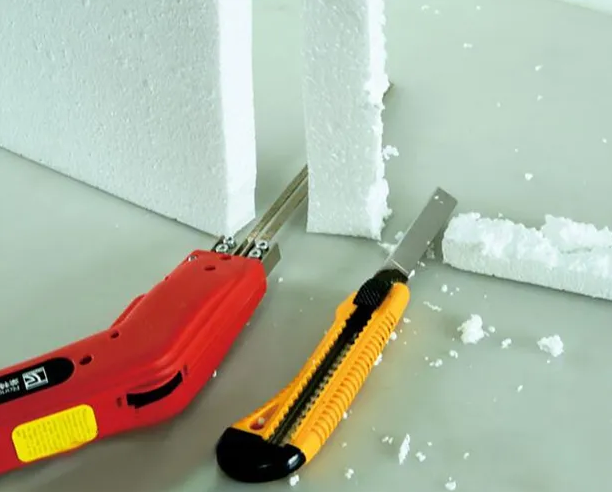
The material resists the effects of household and construction chemicals - asphalt, gypsum, soda and soapy water. Extruded polystyrene foam reduces the level of extraneous noise by 30-35 dB.
According to manufacturers' data, it can be operated for 50 years. At present, this period cannot be exceeded by any heat-insulating material. True, practical information will appear only after several decades.
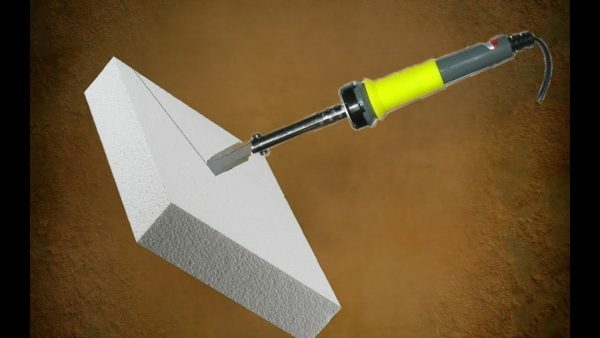
It is better to prepare Penoplex parts of the required dimensions using cutting, this is done in several ways.
- With a stationery knife. It's an affordable, quiet way to cut, and the job gets done quickly. The cut quality of the material depends on the sharpness of the blade;
- Electric jigsaw. The disadvantage of this method is the uneven edge of the segments. But you can cut the required number of pieces in a short time. The jigsaw makes it possible to cut Penoplex of any thickness;
- Kitchen knife. The tool can be found in any home, but you need to sharpen the blade sharply before cutting. Before work, the knife is heated, the heated metal cuts the insulation perfectly. During work, debris does not appear, the cuts are smooth;
- Nichrome wire. This method allows you to perform figured cutting; you will need to connect a nichrome thread to a transformer that produces 24 V. When power is supplied, the wire heats up and can cut the insulation.
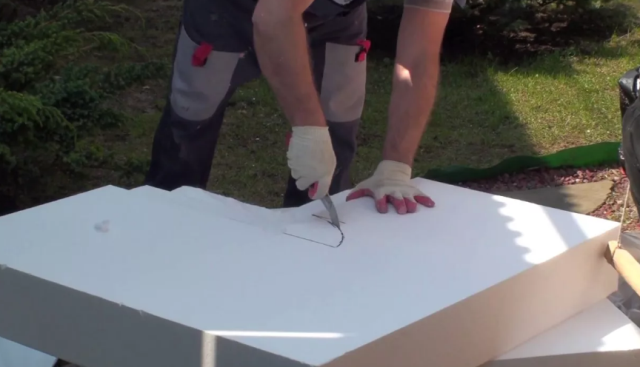
Penoplex is not afraid of the influence of alcohol, acids are not terrible for it, various alkalis, natural gas, vegetable fats and ammonia are not dangerous for it. Penoplex in structure is extruded polystyrene foam, according to the tests carried out, it can be operated for about 50 years.
Differences in laying technology
It is better to mount sheets outside the building. The technology of extruded polystyrene foam production involves the transfer of the "dew point". External thermal insulation reduces heat loss in half. Plates are covered with plaster or siding.
Important! To make effective thermal insulation and improve the quality of sound insulation, the boards must be placed tightly. Laying work begins from the bottom, otherwise the material on the uncured glue will slide down.
Penoplex is fastened in 2 ways:
- On the glue. For reliability, the fastening of the plates is reinforced with dowel-umbrellas;
- Ventilated facade. A crate is made from wooden slats or a metal profile, insulation is placed in the cells, and everything is sewn up with cladding.
When insulating the facade of a house with expanded polystyrene, unusual decor is often used. Penoplex is covered with various plaster and mosaics, and other materials are used to distinguish them from other buildings.
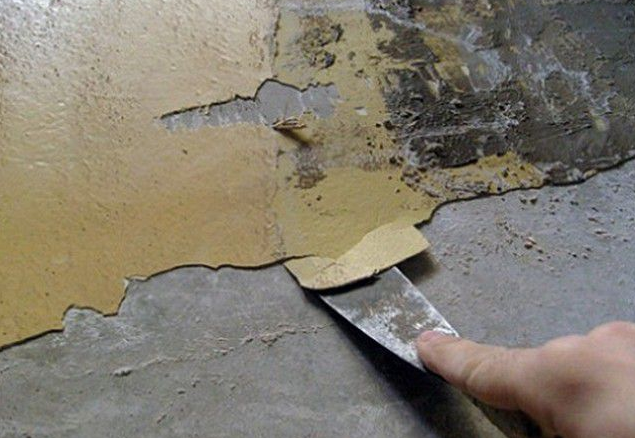
It is better to use slabs with a tongue-and-groove edge. This makes it possible to prevent the appearance of cracks and cold bridges. Penoplex of the PPS 25-RG-B brand is often used.
Price
Expanded polystyrene can be bought from 1300 rubles for 1m3. The cost may vary depending on the raw materials used in the production. This also affects the grade of the material, what is the difference between Penoplex in terms of density and range of operating temperatures.
Cost of 1m3 Penoplex 3.5-4.5 thousand rubles. It may differ depending on your region and the season of purchase of the material. Often, when buying in bulk, the material can be purchased cheaper, often the total volume of the purchase affects the size of the discount.
When buying, you need to take into account the need to cut the material and fit individual elements, for this reason, it is necessary to increase the volume of the purchased batch of insulation by 10% of the calculated one.
